Schedule a Call
Get started with your organic growth journey!



Get insights on AI, productivity, and the future of work.



Industrial sales used to start with outreach. Today they start with research. Buyers don’t want pressure. They want clarity. They want proof. They want to feel confident in a partner long before they ever schedule a call.
This means the companies winning the best industrial sales leads are more helpful, more visible and more consistent. They show buyers what they know, how they work, and why their solutions matter.
Strong industrial leads are the result of intentional communication that meets buyers where they already are: learning, evaluating, and deciding. And your business can guide every step of that journey.
Lead generation in the industrial world involves identifying companies that genuinely need a new supplier or have an upcoming project. These buyers move slower than consumers and usually involve several people in the decision. They care about your capabilities, certifications, tolerances, and whether you can support them long term.
In this space, a lead is a buyer with a real technical need, a timeline, and the authority to move a project forward. Effective lead generation helps these buyers discover your capabilities early, understand what you can handle, and trust you enough to start a conversation or issue.
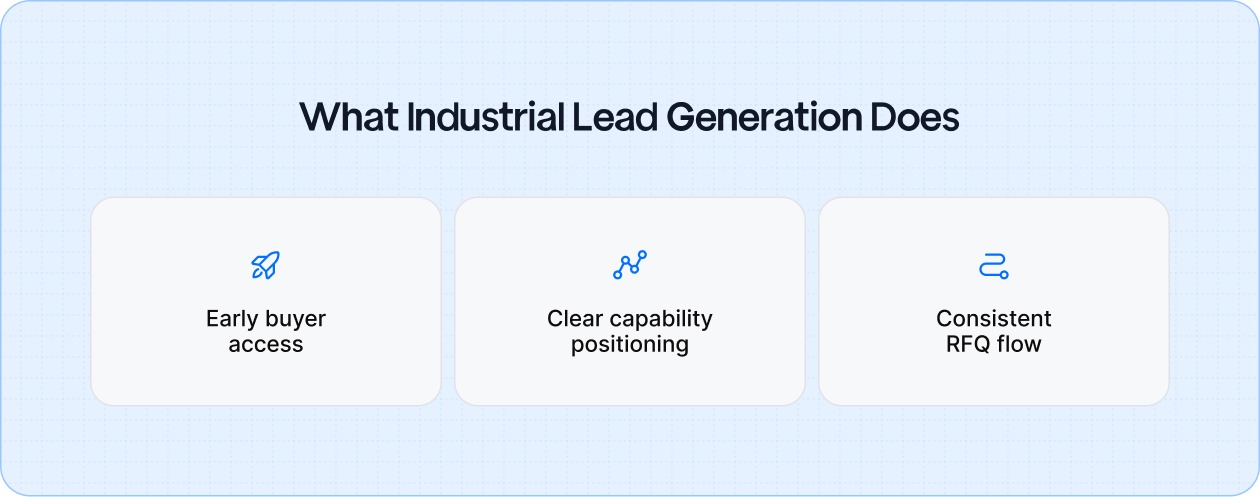
Industrial lead generation does three things for you:
Below are the methods that consistently attract the right kind of leads, the ones with defined needs and a high chance of becoming repeat customers.
Most industrial companies already have a product catalog or capabilities brochure. The problem is that it often sits as a static PDF, buried three clicks deep on the website.
To make your catalog generate leads:
When your catalog is easy to search and tied to RFQ or enquiry forms, it becomes a continuous source of qualified industrial sales leads, not just a reference document.
Industrial buyers and engineers spend a lot of time researching before they ever speak to sales. Your website should help them do that work.
Useful content that supports lead generation:
The more your website answers real technical questions, the more often you’ll earn contact from serious buyers.
Want a quick health check on your website? Drop it into our AI Analyzer and get instant insights to help turn more visitors into paying customers.
Video remains underused in manufacturing, yet engineers and buyers watch videos to understand processes, compare suppliers, and validate capabilities.
What to create:
Video builds trust faster than text. Seeing your machines, people, and process reduces perceived risk, especially for buyers sourcing a new supplier.
A generic “Contact us” form attracts everything from students to one-off prototype requests. Quotation forms and project enquiry forms let you qualify leads earlier.
To make forms work for you:
A focused prospect form helps your team decide which leads to call first and which to park or decline politely.
Industrial buyers rarely start on social media. They start on channels built for engineering and sourcing. Your job is to show up there with clear, technical information.
Places to consider:
If you invest time or budget in these channels, make sure your listings:
Treat each platform as a feeder into your own website and sales process, not as a disconnected listing.
GBP is one of the most overlooked sources of high-intent industrial sales leads, especially for regional manufacturers, fabrication shops, job shops, and machining companies.
What to do:
A strong GBP helps you appear when local engineers and buyers search things like “metal fabrication near me”, “precision machining supplier”, or “custom PCB assembly shop”.
Email still works in manufacturing, as long as it respects the receiver’s time and context.
Two main use cases:
To keep email effective:
Email becomes a lead generation tool when each message connects a real problem to a specific capability you can offer.
In manufacturing, a single account can represent years of revenue. That makes account-based thinking more practical than chasing random leads.
To align around key accounts:
The goal is not just more names in the database, but deeper engagement inside the companies that matter most to your growth.
Trade shows and webinars are expensive if they only deliver business cards. They are valuable if they feed into a structured follow-up process.
To make events generate industrial sales leads:
Think of events as concentrated lead generation moments. The real value is harvested in the weeks after, not only during the trade show marketing.
If you sell through distributors, reps, or integrators, they are also a source of industrial sales leads. But they need more than a logo and a price list.
Give partners tools that directly support lead generation:
When partners are equipped to explain where you fit best, you receive cleaner, better-qualified opportunities instead of mismatched requests.
Industrial purchasing rarely depends on one person. Engineers, procurement, quality, and operations all influence decisions. A multi-channel approach ensures your brand shows up at different stages of their process, even when they’re researching quietly.
How to use it effectively:
Multi-channel doesn’t mean “be everywhere.” It means showing up where your specific buyers already look for suppliers.
Without measurement, it’s easy to over-invest in channels that generate “activity” rather than revenue.
At a basic level, track:
You don’t need a complex dashboard to start; a simple monthly review with sales is enough to see what is bringing in leads worth quoting and what is not.
Not every enquiry deserves the same amount of time. Clear qualification criteria help your team focus on leads that can become profitable, repeat business.
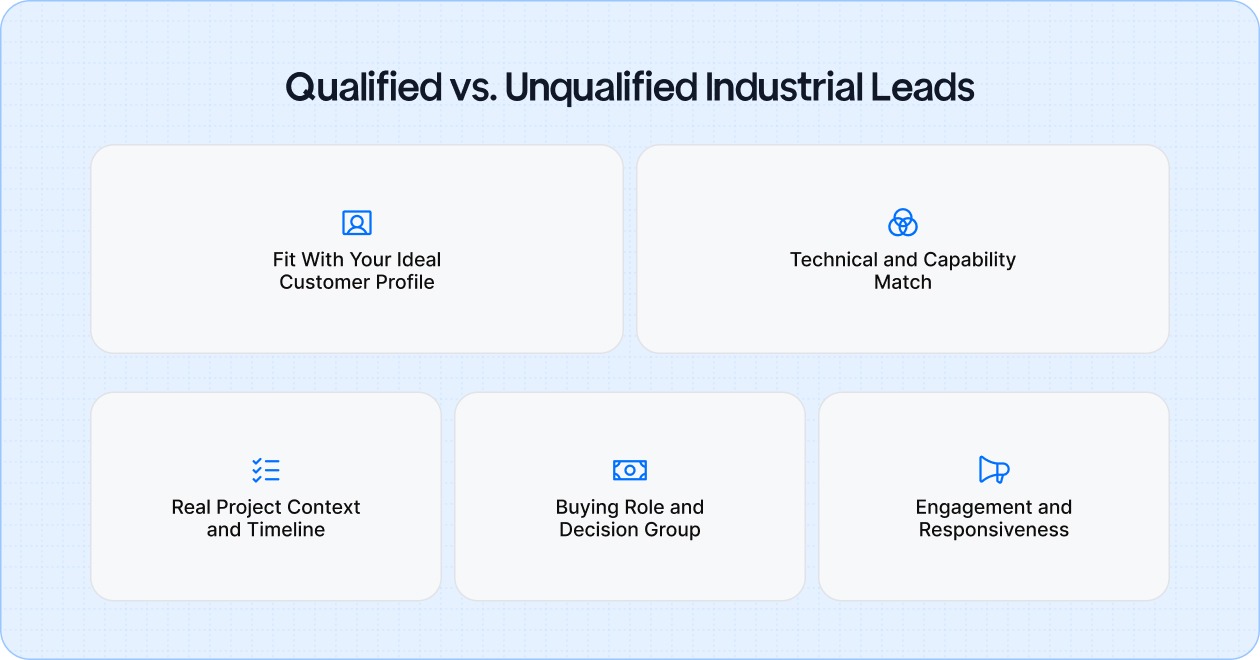
A qualified lead usually:
Non-qualified leads often sit outside your target sectors or require project sizes that are too small (or occasionally too large) for you to serve well.
Check whether:
If a lead needs something you have never done, or that would disrupt your core production, it may be better to decline or refer.
Qualified industrial sales leads usually come with a clear context:
Red flags include vague timing (“sometime next year”), no clear use case, or a request that appears purely exploratory with no identified project behind it.
In B2B manufacturing, the person who contacts you may be:
All can be valuable, but a qualified lead usually has visibility into the broader decision group or is willing to involve others. If a contact cannot explain who approves suppliers, who signs off on specs, or how sourcing decisions are made, treat it as early-stage until that clarity is gained.
Lead quality also shows up in behaviour:
If a prospect goes silent for weeks, refuses to share basic information, or only asks for “your best price” without dialogue, they may be more interested in price shopping than true partnership.
To make this practical, you can build a short checklist for every new lead:
If most answers are “yes,” you have a qualified industrial sales lead. If several are “no” or unclear, treat it as lower priority or nurture until it matures.
The companies that grow steadily are the ones that make it easy for the right buyers to understand what they do, see proof that it works, and start a focused conversation.
If you turn your catalog into a working asset, build flows that filter instead of flood, show up in the channels your buyers already use, and agree internally on what “qualified” really means, lead generation stops being guesswork. It becomes another well-run process in your operation, measured, improvable, and tied directly to the kind of business you want more of.

Here’s something most cabinet businesses don’t realize. Homeowners don’t start their search by asking, “Who installs the best cabinets?” They start by asking, “Who looks competent enough that I won’t regret hiring them?”
And the place they make that judgment isn’t your workshop, gallery, or referral network. It’s your search results.
Before someone ever steps into your showroom or books a consultation, Google is already shaping their opinion of your business.
This is where strong cabinet installation SEO pays off.
In this blog, you’ll learn the complete SEO framework that helps cabinet installers to attract better clients, win higher-value jobs and appear as the most trustworthy choice the moment someone searches.
Cabinet installation SEO is the process of improving your online presence so homeowners can find your business when they search for services. It helps search engines understand what you do, the styles you offer and the areas you serve so you show up in the exact moments buyers are ready to compare, shortlist and request quotes.
SEO directly affects how many people discover your business and how many of them turn into real projects. Here’s why it matters:
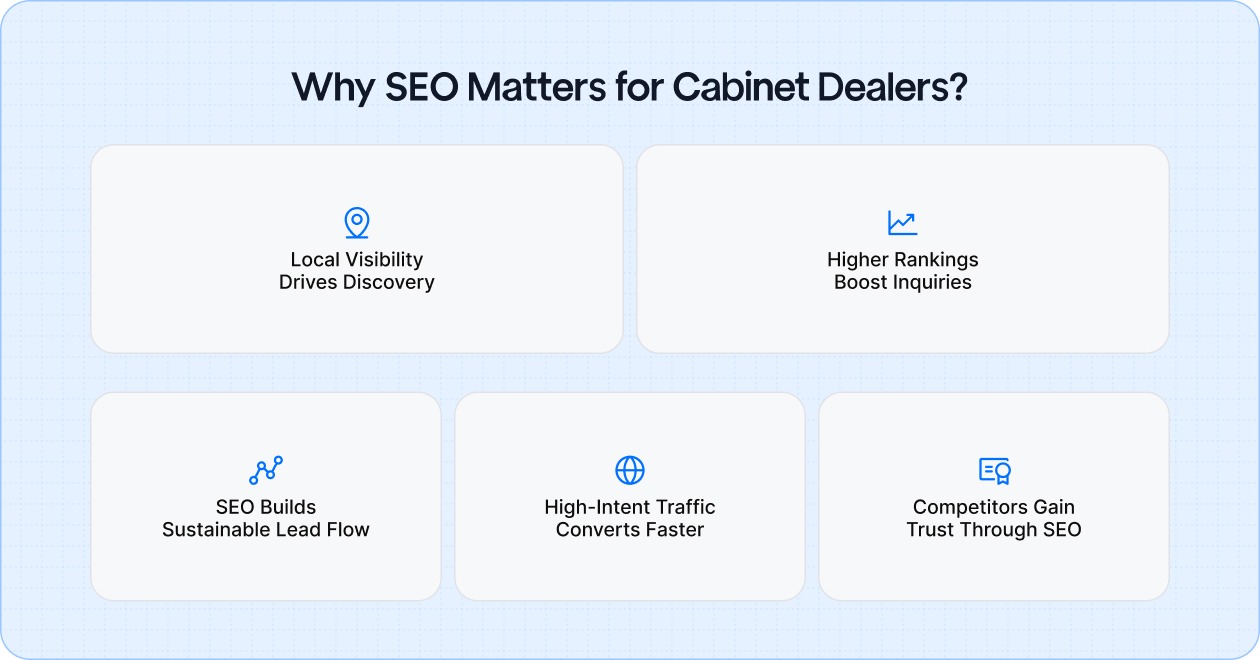
This section breaks down the core elements that help cabinet installers, makers and dealers get found by qualified buyers.
Before you touch keywords or service pages, you need to understand who you actually want to attract. A homeowner planning a kitchen makeover has very different expectations from a contractor looking for a reliable installation partner. When you get clear on each group, your SEO becomes sharper, more relevant and far more profitable:
These are the audiences most cabinet businesses work with. Each one searches differently, compares differently and has different priorities.
Each type of buyer enters SEO at a different point.
Cabinet buyers search with clear intent. They know their style, their budget and the type of work they need. Your job is to match your pages to those specific searches so Google can pair you with real, ready-to-buy customers.
Long-tail keywords are longer, more specific search phrases like “modern shaker cabinet installation in Austin.” They bring far better leads than broad terms because they reveal what the customer actually wants. Each category below aligns with a real buyer decision, which makes them incredibly valuable for cabinet businesses.
These attract homeowners who already have a look in mind.
These searches signal high intent because people searching by style are often close to making a design decision.
These bring in people who know the exact type of work they need.
Service terms match bottom-of-funnel intent, meaning buyers are ready to talk to someone soon.
Cabinet installation is a local service. Using city or neighborhood terms helps you show up for local searches.
These improve map rankings and help you appear for high-intent local jobs.
These are the searches people make when they’re almost ready to hire.
These keywords bring the most profitable leads because the customer is close to making a decision.
Search Console is one of the simplest ways to see which keywords you’re already showing up for and where you’re losing potential traffic. It helps you spot pages that need improvement so you can climb into the top results where the calls actually happen.
Look at the keywords getting impressions but low clicks. This means you're being seen but not chosen.
Search Console shows which service or location pages appear on page 2 or 3.
Sometimes your page ranks for something you never optimized for.
Pages already indexed for the right keywords just need better content.
This alone can move rankings quickly because Google already considers your page relevant.
Cabinet installation is a location-based home service. Homeowners rarely hire outside their immediate area, which means Google Maps, local search signals and nearby credibility matter more than anything else.
These work together to build strong local visibility.
Your Google Business Profile is often the first place customers see your business. When optimized well, it brings in a steady flow of calls without paying for ads.
What to focus on:
Many homeowners search from iPhones, which means Apple Maps plays a bigger role than most cabinet businesses realize. If your listing isn’t claimed or updated, you miss out on high-intent local traffic.
What to focus on:
A polished Apple listing strengthens your local presence and captures buyers who never check Google but rely entirely on their iPhone for nearby services.
On-page SEO is everything you adjust on your website to help Google understand your services and help homeowners understand why they should choose you.
Below are the most important on-page practices for cabinet installers, dealers and makers:
A strong cabinet website speaks to two audiences at once: homeowners and Google. The key is clarity. The easier it is for both to understand what you offer, where you work and why you're the right choice, the better your results.
What to do:
A clean, straightforward site builds trust quickly and strengthens your rankings at the same time.
Want to improve your site but don’t know where to start? Let our AI Analyzer review it and show you the changes that matter most.
Landing pages are built for one purpose: turning visitors into leads. They remove distractions and highlight the one action you want people to take. For cabinet businesses, strong landing pages can drastically increase quote requests.
What to include:
Good landing pages help turn ad clicks, email traffic and SEO visitors into actual customers.
Helpful content attracts qualified traffic and positions you as an expert. Homeowners search for answers before they commit to a project. If your website provides those answers first, you win the lead.
Content types that work best:
The goal is to educate, not oversell. When you teach well, buyers trust you naturally.
These are the technical pieces that tell search engines what your page is about. They might sound complex, but they’re easy once you know what to do.
What to include:
These elements help your pages appear for the right searches and improve ranking stability.
Cabinet projects rely heavily on visuals. Google also uses images to understand your work and match you with style-based searches. Proper optimization improves both rankings and conversions.
How to optimize:
Images are some of your strongest SEO assets. Optimizing them helps homeowners trust your work instantly.
Technical SEO is the behind-the-scenes work that helps your website load fast, stay accessible and get properly indexed by search engines. Homeowners won’t see these elements directly, but they absolutely affect whether your pages rank and whether visitors stay long enough to contact you.
A slow website costs you leads. Homeowners leave quickly if pages take too long to load, especially on mobile. Google also prioritizes sites that feel fast and stable.
What to do:
Fast websites convert more visitors and signal professionalism.
Most homeowners search for cabinet installers on their phones, especially during remodeling research. If your site doesn’t look clean and simple on mobile, they leave instantly.
What to do:
A mobile-ready site helps you capture traffic from people browsing on the go.
Indexing means Google can successfully read and list your pages. If important pages aren’t indexed or links are broken, your rankings suffer and customers may hit dead ends.
What to check regularly:
SEO only improves when you know what’s working. GA4 and Google Search Console (GSC) give you clear insights into traffic, engagement and ranking performance.
What to monitor:
Regular tracking helps you make better decisions and spot issues before they become bigger problems.
Off-page SEO includes all the signals that live outside your website but help search engines and homeowners see you as a credible, established cabinet installation business.
Quality backlinks tell Google that reputable sites trust your business.
What works best:
These links help you appear more authoritative in your niche and improve local rankings significantly.
Reviews are one of the strongest trust signals for cabinet installation. Search engines reward businesses that collect steady, authentic feedback.
How to make reviews work for you:
A steady flow of recent reviews boosts both conversions and local map rankings.
SEO becomes even stronger when supported by complementary channels that build visibility and trust over time. These channels capture homeowners who are comparing options, browsing for ideas or planning remodels months in advance:
Paid ads like Google PPC and Local Service Ads are useful when you want fast visibility or want to target high-value areas.
Why they help:
Paid ads work best when paired with strong landing pages and a solid SEO foundation.
Cabinet installation is a highly visual service. Your transformations often sell the service better than words.
Where to focus:
Each platform helps different types of buyers discover your work early in their research.
Many homeowners take weeks or months to decide on cabinets. Email helps you stay top-of-mind during this decision window.
How it helps:
Email nurtures slow-moving leads that SEO brings in.
When you’re investing in SEO for a cabinet installation business, the right agency should make growth feel simpler, not more confusing. You need a partner who understands home improvement buyers, local search and how homeowners actually choose cabinet installers.

Here are the qualities that matter most in an SEO agency:
Heading: Strengthen Your Local Visibility
Subheading: Boost rankings with better structure, speed, GBP optimisation and clear service pages.
Button Text: Fix My SEO
Strong SEO doesn’t just help people find your business. It helps them understand what makes your craftsmanship worth choosing. When your pages answer real questions, your service details are organized and your location signals are clear, homeowners feel more certain about moving forward.
Over time, this creates steadier inquiries, higher-value project opportunities and a reputation that grows beyond word of mouth. SEO becomes the structure that supports your marketing, your sales process and the way homeowners perceive your brand long after that first search.

If you work in agricultural manufacturing or supply, you already know the challenge isn’t making a good product. It’s making sure the right buyers ever see it.
The market is packed with long-standing brands, regional dealers, emerging tech, and copycat competitors who all promise the same things: durability, efficiency and better yield. In this environment, even strong products get buried if your online presence doesn’t signal authority from the start.
That’s where B2B SEO becomes a real advantage. Instead of hoping they discover you, SEO helps you show up where their research actually happens.
In this blog, you’ll learn how B2B SEO works for agricultural suppliers, the strategies that attract qualified manufacturing and distribution leads, and the best practices that help your brand rise above competitors in a crowded, fast-evolving industry.
A good SEO strategy helps you get discovered early in their research process, answer the questions they care about and position your company as a trustworthy, proven solution.
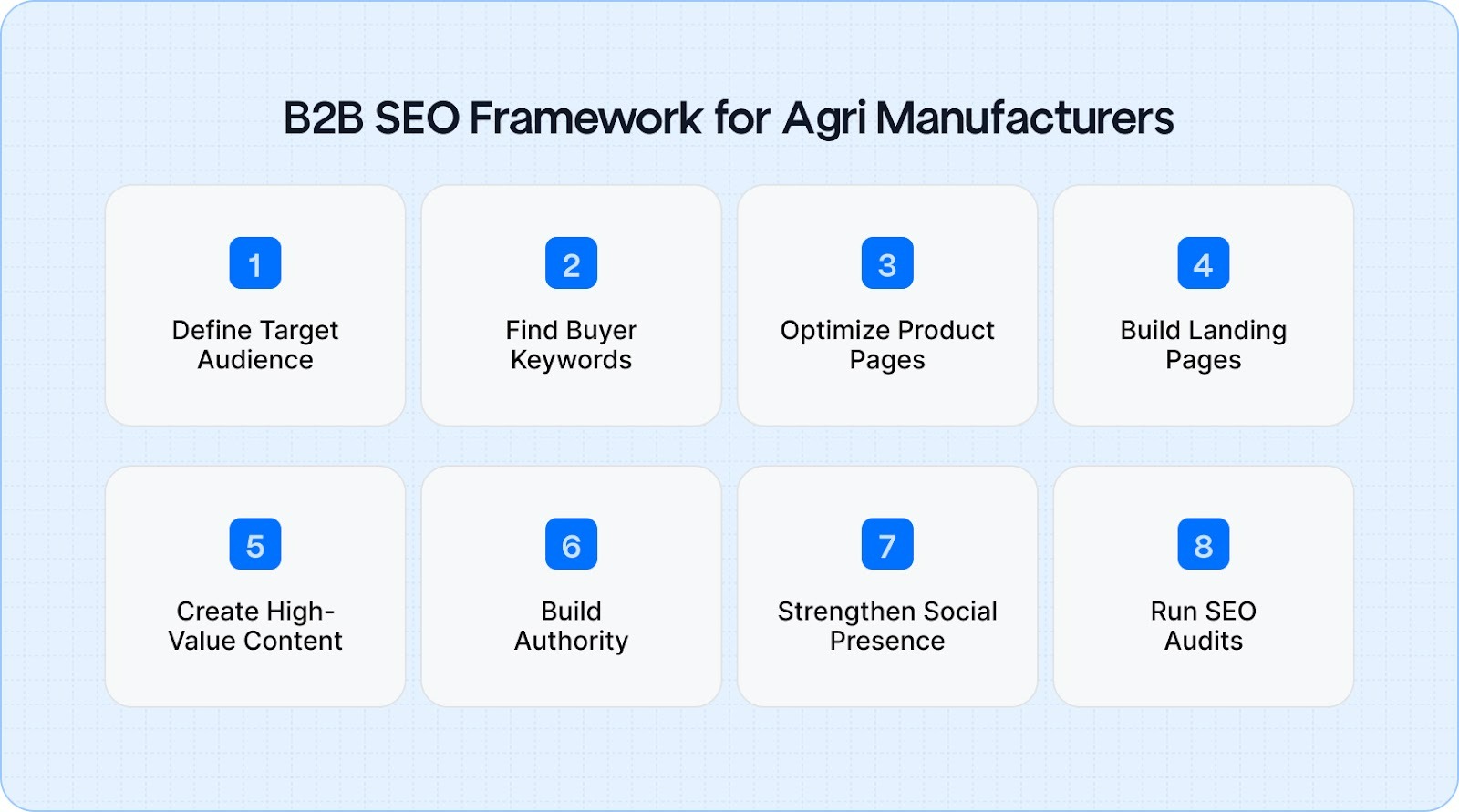
The steps below break down what today’s most effective agricultural manufacturers are doing to grow high-quality traffic and leads online:
This is the foundation of every successful B2B agricultural marketing strategy. If you don’t clearly understand who you want to reach, your SEO won’t match the right search intent and you’ll attract the wrong buyers.
What to clarify:
Start with 3–5 personas so your content and keywords have real direction.
Agricultural buyers search based on the problem they want solved, the machine they operate or the technical feature they need.
Breaking your keyword research into buyer-journey stages makes everything more accurate:
Buyers focus on understanding a problem or finding general guidance. Use broad pain points and helpful educational topics rather than product-heavy terms.
Target, pain-point keywords like “reduce feed waste,” and “automated grain handling,” or how-to searches like “how to automate fertilizer application,” and “how grain dryers work.”
They shift toward exploring possible solution types. Highlight features, benefits, and categories so they can compare approaches without diving into brand specifics yet.
For example, “precision ag software benefits” and “automated sprayer systems.”
Buyers start shortlisting vendors. Focus on comparison content, proof points, and search terms that show a clear intent to evaluate suppliers.
For example, comparison terms like best grain auger supplier,” “top fertilizer pump manufacturers,” or vendor-intent keywords like “bulk order agricultural sprayers,” “OEM tractor attachments supplier.”
Product pages are where real B2B purchasing decisions happen. Buyers care about specs, performance data, ROI, safety, compatibility and supporting documentation.
Best practices:
These reflect high buying intent: model numbers, equipment features, capacity, application type.
How to get the best results
Some agricultural machinery keywords are too broad to rank a single product page. These phrases belong on your homepage, which acts as your main brand positioning page.
How to get the best results
This is about helping both search engines and buyers clearly understand what each page is about. If the details are missing or unclear, Google won’t rank the page and buyers won’t convert.
Below is how to optimize each element cleanly and accurately:
Your product pages must answer every question a buyer might ask before speaking with sales.
Landing pages convert traffic into actual leads. The more aligned they are with your call-to-action, the higher your conversion rate.
Types of landing pages:
Agricultural buyers often share landing page content across departments. A precise, clear landing page reduces confusion and speeds up the internal approval process.
Content is the engine of B2B agricultural SEO. Buyers do a lot of research before reaching out, especially for expensive machinery or high-volume supply contracts.
Below are the types of content that work best and how to use each one effectively.
Educational blogs explain problems, solutions and everyday challenges in simple language. These posts attract buyers who are researching long before they reach out.
Tips to get the best results
Technical explainers break down the engineering, features or performance benefits behind your products. These help buyers understand why your equipment works the way it does.
Tips to get the best results
Videos, like field demos, comparison tests and operator walk-throughs, help buyers see your product in action. This makes complex machinery easier to evaluate.
Tips to get the best results
Repurposing means taking one piece of content and turning it into multiple formats. This lets you get more reach without creating everything from scratch.
Tips to get the best results
These are the ways the right SEO strategy supports food and agricultural businesses.
Avoid talking only about yourself. Your audience searches for solutions and expertise, not promotions.
Content alone won’t rank. You need authority signals. How to build authority:
A steady presence helps you stay visible during long buying cycles.
Below is what matters most and how each part supports your marketing.
LinkedIn, YouTube and Facebook remain the best platforms for agricultural audiences.
A fast, error-free, technically solid website ranks better and converts better.
Areas to audit:
Review monthly in the first six months, then quarterly.
Checking your site’s performance is easy. Put your URL into our AI Analyzer and get straightforward suggestions that help you win more jobs.
Agricultural SEO requires technical product knowledge and industry context.
What to look for in your SEO partner agency:
The right partner will know how to speak to buyers in a way that creates trust and action.
Below are the most common challenges, with simple solutions:

Agricultural machinery purchases rarely happen fast. Buyers compare brands, debate options internally and wait for the right season or budget cycle. This means you must stay visible and helpful throughout the entire decision process.
How to solve it
Big-ticket machinery creates hesitation, even when buyers see the value. Many simply want help understanding how the investment pays off in the long run.
How to solve it
Modern agricultural equipment often includes software, sensors, telematics or automation features. Buyers worry about learning curves, compatibility and usability.
How to solve it
Different regions have unique safety rules, emissions standards, warranty expectations and import/export restrictions. This slows purchasing and confuses buyers.
How to solve it
SEO is only one part of how agricultural buyers discover and evaluate suppliers. That means your marketing needs more than rankings. It requires a presence everywhere your buyers spend time learning, comparing and validating.
Below are the most effective marketing channels agricultural manufacturers use today, and why each one still matters:
Digital marketing plays a major role because buyers start their research online long before speaking to sales. These channels help you stay visible early in the buying cycle.
Digital channels feed awareness and education, helping you get noticed before your competitors do.
Agricultural equipment is often sold through dealer networks, so strong partnerships amplify your reach.
Dealers are often the closest to the buyer. Supporting them strengthens your visibility and sales pipeline across multiple regions.
Despite digital growth, agriculture remains a relationship-driven industry. Face-to-face trust still matters a lot.
Traditional channels create the personal credibility and confidence that digital marketing alone cannot match.
Strong B2B SEO doesn’t replace your dealer network, trade shows or long-term relationships. It strengthens all of them. It brings in better-fit prospects, shortens conversations and positions your company as the supplier that understands the industry and its challenges.
Build your presence now, and you’ll stay ahead of competitors. In agricultural manufacturing, trust is currency and visibility is leverage. SEO gives you both.

In the packaging world, great engineering isn’t enough. Plenty of companies can produce strong materials or flawless structures. What separates the ones that scale from the ones that stall is something far simpler: the clarity of their message.
The best packaging companies create the demand. They treat marketing with the same discipline they bring to production, which is why their pipeline feels steady instead of unpredictable.
In this article, you’ll learn the steps to build a packaging marketing strategy that creates steady demand, strengthens customer trust, and supports scalable growth.
A packaging marketing strategy is the simple plan you use to get your packaging business in front of the right buyers and clearly show why they should choose you. It guides how you present your services, build trust, and reach brand owners and buyers who are already looking for packaging help.
Without a clear strategy, you rely on luck. With one, you make it easier for customers to find you, understand your strengths, and contact you with real project requirements.
Here’s why it matters:
A focused packaging marketing strategy helps you stand out in a crowded market and turns interest into real orders without relying on chance.
A simple strategy ties together four things: what you sell (capabilities), who you sell to (audiences), why they should pick you (value), and how they find you (channels). Below are the core areas explained, and how you can implement them:
Positioning simply defines what you do best, who you do it for, and why they should choose you.
Ask (and answer) questions like:
Turn this into a simple positioning line you can repeat everywhere. For example:
“Short-run printed cartons for fast-growing D2C brands in the U.S.” “Food-grade flexible packaging with recyclable structures for mid-sized FMCG brands.”
A sharp position makes content ideas, outreach lists, and ad targeting much easier.
Your website is often the first meeting a buyer has with your company. A packaging website must behave like a structured, technical guide that helps buyers understand your manufacturing capabilities, materials, certifications, and fit.
Elements of Website for Packaging Companies:
Show how your packaging works for different industries, like cosmetics, food, beverages, pharmaceuticals, electronics, etc.
Good quotation forms filter out mismatches by capturing:
This protects your team from poorly defined or low-value enquiries.
Treat every page as if it needs to convince a busy buyer in under 30 seconds that you know what you’re doing.
SEO for packaging involves creating pages that match real searches. These searches look like:
What to do:
SEO is slow but powerful: once pages rank, they bring in a steady stream of qualified visitors without ongoing ad spend.
Paid search (Google Ads, Bing) helps you appear for high-intent searches while SEO grows.
You should evaluate ads based on qualified leads, not impressions or clicks.
Your buyers are on LinkedIn and in email all day. This is where “printed circuit boards direct marketing” and packaging marketing are similar: it’s about targeted, helpful contact.
The tone should feel more like an engineer sharing something useful than a salesperson pushing a brochure.
These platforms give buyers quick visibility into the suppliers they are comparing. Your presence must be complete and technically accurate. Buyers still search on:
Make sure:
Great packaging content solves the exact questions buyers wrestle with before they even think about suppliers.
Distribute this content via your website, LinkedIn, email newsletters, and as attachments in one-to-one outreach. It builds trust long before any contact.
Events like PACK EXPO, interpack, and regional packaging shows still matter. Buyers walk floors, compare suppliers, and collect cards.
The difference between “expensive booth” and “profitable booth” is prep and follow-through:
Think of shows as a concentrated lead-generation sprint that feeds your ongoing digital nurturing.
Your marketing strategy must filter, qualify, and nurture enquiries so your sales and engineering teams spend time on the right opportunities. Your packaging marketing strategy should also:
Measure what matters:
These metrics show whether your marketing is producing real commercial value.
Your packaging company already has value. Marketing is just how you make that value visible. And when you do it well, you stop blending in and start becoming the supplier buyers remember first.
Clear communication turns confusion into interest. Real proof turns interest into trust. Consistent visibility turns trust into new orders.

Manufacturing teams are sitting on years of production data, maintenance logs, design files, and operational notes, yet most of it never shapes daily decisions. Design changes still take weeks, machine issues surface after downtime begins, and critical insights remain scattered across disconnected systems.
Generative AI changes this reality by turning existing operational data into usable outputs. For small and medium manufacturers, this matters because meaningful AI adoption no longer depends on large engineering teams or long deployment cycles.
This article breaks down where generative AI is delivering measurable value for manufacturers right now, with real use cases and examples that map directly to day-to-day operations.
Generative AI helps produce drafts, recommendations, summaries, and design options that teams can act on directly. Data like machine logs, maintenance records, drawings, and planning notes often sit unused across systems. Generative AI connects these inputs and converts them into clear, execution-ready outputs.
In manufacturing environments, generative AI is commonly used to:
Large language models (LLMs) and natural language processing (NLP) enable these systems to work with the same technical language that manufacturers already use. This reduces interpretation effort and helps teams move faster without changing how they work.
Generative AI is not a replacement for core manufacturing systems, engineering judgment, or operator expertise. Its value lies in summarizing information, prioritizing actions, and supporting execution, not in taking control away from people or systems.
Must Read: How Generative Optimization Enhances AI Search Visibility
Generative AI delivers financial impact in manufacturing well before large-scale automation or capital-heavy upgrades come into play. For SMBs, the most immediate gains come from reducing inefficiencies that quietly drain time, budget, and attention across daily operations.
On the operational side, AI reduces avoidable costs by automating work that traditionally relies on manual intervention:
Beyond operations, AI improves decision quality by turning production data, maintenance logs, and planning inputs into clear, actionable summaries. Teams spend less time interpreting information and more time acting on it, reducing delays and costly missteps.
Yet much of the financial leakage for SMB manufacturers occurs before production even starts. Poor content visibility, unclear buyer intent, and manual marketing execution often result in missed opportunities or underqualified inquiries, pulling sales teams into low-value work.
AI-assisted content and search systems help align inbound demand with operational capacity, cutting wasted effort across sales, marketing, and leadership.
Generative AI in manufacturing use cases are producing ROI because they turn existing data into actions teams can use immediately. For SMBs, these wins show up without major system changes or large internal teams.
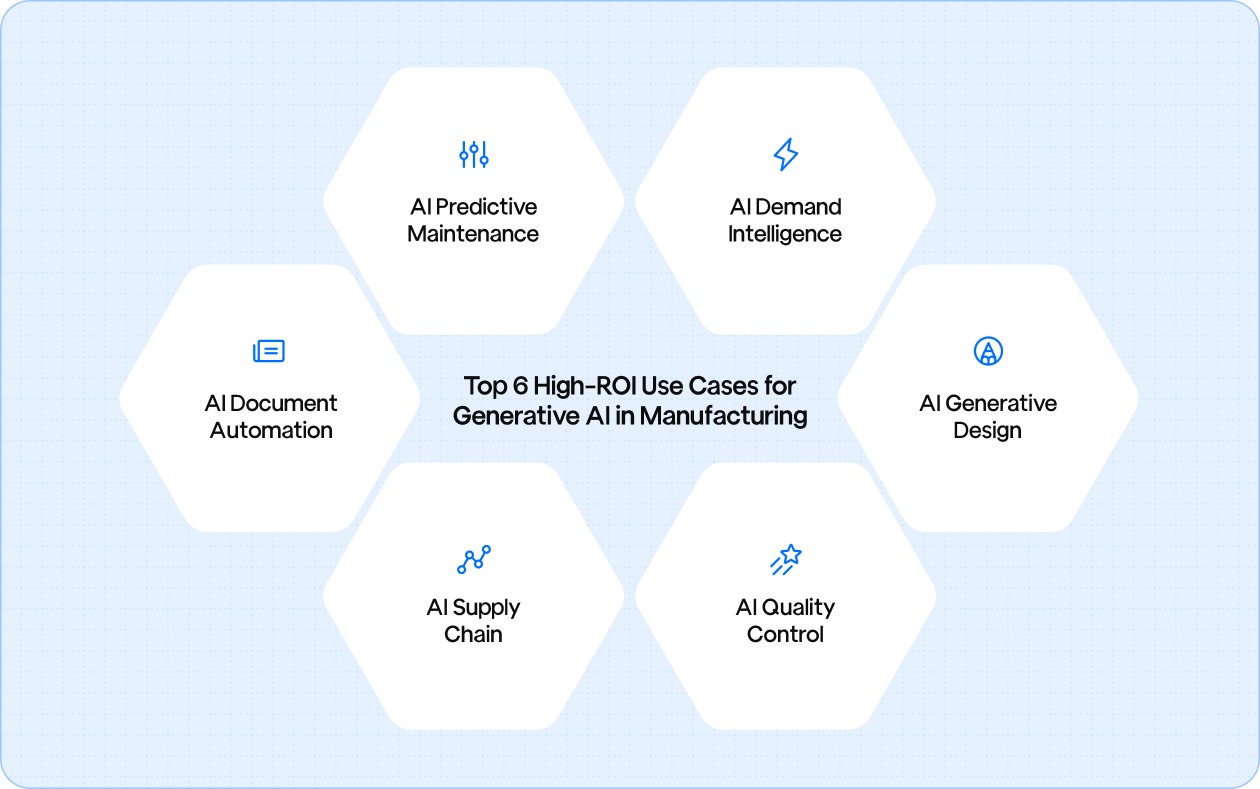
Here are the high-ROI use cases reshaping the industry.
Traditional maintenance models depend on fixed schedules or reactive repairs after failures occur. This often results in over-servicing healthy equipment or dealing with sudden breakdowns that disrupt production.
Generative AI changes this approach by evaluating multiple data sources together and surfacing issues earlier, with clearer context.
Rather than flooding teams with disconnected warnings, generative models help maintenance teams quickly understand which machines need attention, what is driving the risk, and how soon intervention is required.
Over time, predictive maintenance powered by generative AI leads to lower repair costs, better asset utilization, and more predictable operations.
Generative AI is increasingly being used beyond the factory floor to understand how manufacturing buyers research and make decisions.
Manufacturing purchases involve long, technical evaluation cycles. Buyers search for specifications, applications, comparisons, and implementation details long before contacting sales. When manufacturers fail to appear during this research phase, demand quietly shifts elsewhere.
Rather than producing broad marketing material, manufacturers can use generative AI to create application-specific pages, technical explainers, and comparison content that matches how engineers and procurement teams actually search.
Traditional design cycles in manufacturing are slow and constrained by limited iterations. Engineers often settle on workable designs early because exploring alternatives takes time, tooling, and coordination.
Generative AI changes this by rapidly producing multiple design options based on defined constraints such as strength, material limits, cost, and manufacturing feasibility. Instead of starting from scratch each time, teams review AI-generated options that already meet core requirements.
For SMB manufacturers, this means better designs without expanding design teams or extending development timelines.
Manual inspection and rule-based quality checks struggle to keep up with production speed and variation. Subtle defects are easy to miss, and inconsistencies often surface only after products reach customers.
Generative AI-supported quality systems analyze images, sensor outputs, and historical defect data together. Instead of flagging isolated anomalies, they summarize patterns and surface likely defect causes early.
For SMBs, this improves quality and reliability without slowing production or adding inspection layers.
Supply chain decisions are often made using fragmented data: historical demand in one system, supplier lead times in another, and planning assumptions stored manually. This leads to overstocking, shortages, or reactive purchasing.
Generative AI brings these inputs together and produces summarized demand and procurement guidance. Instead of raw forecasts, teams receive clearer signals on where risk is rising and where adjustments are needed.
For SMB manufacturers, this reduces working capital strain while keeping production schedules stable.
Technical documentation is essential in manufacturing, but producing it manually is slow and error-prone. Quotes, service manuals, and work instructions often rely on copying information across systems, increasing risk and rework.
Generative AI automates document creation by pulling from existing specifications, historical documents, and structured data. Instead of starting from blank pages, teams review ready drafts aligned with current products and processes.
For SMBs, this frees skilled teams to focus on production and customer decisions instead of paperwork.
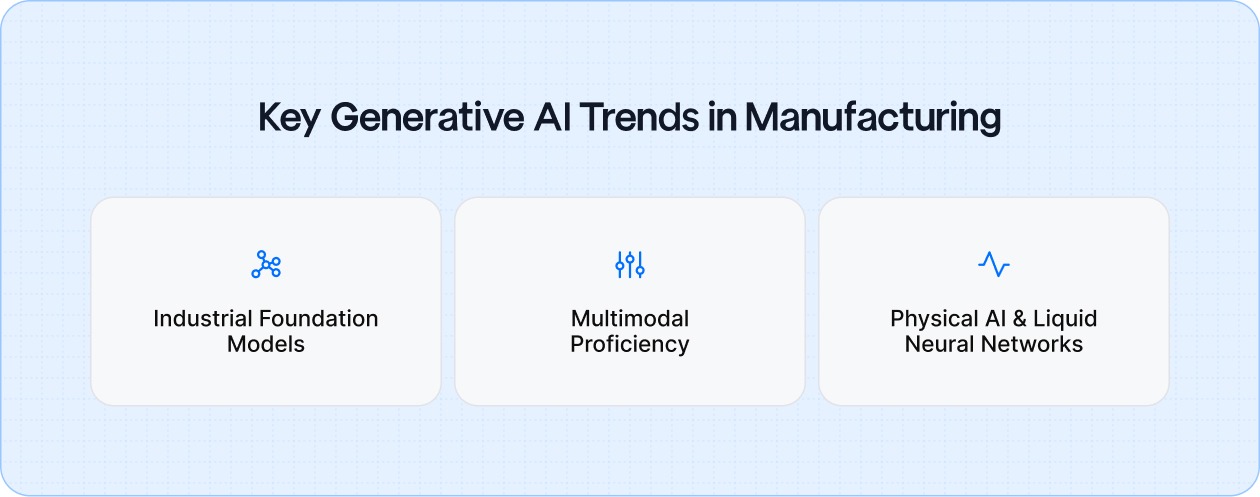
New tools do not define the future of smart production, but by how quickly insights turn into action. The trends below show where generative AI is reducing lag between data, decisions, and execution. Here are key trends transforming the industry:
Industrial Foundation Models (IFMs), trained on manufacturing-specific data, prioritize actionable insights over additional dashboards. They reduce cognitive load by surfacing execution-ready recommendations, allowing teams to act faster without adding overhead.
Example: A model that reads downtime logs and suggests the next three maintenance checks.
Multimodal AI connects diverse data sources (logs, images, sensor readings) to provide summarized, actionable insights automatically, eliminating manual data stitching and speeding decision-making.
Example: AI correlates vibration, thermal images, and alarm history to predict bearing failure.
Physical AI adapts to real-time conditions, optimizing production by adjusting processes based on immediate feedback. Liquid neural networks support this adaptability by continuously adjusting systems without manual intervention.
Example: Adaptive tuning in robotics when material properties vary.
These manufacturing generative AI case studies highlight how manufacturers are using AI beyond the factory floor to improve visibility, inbound demand quality, and sales efficiency, without adding headcount or reworking internal systems.
Rather than focusing only on production gains, these companies applied AI where buying decisions start: research, discovery, and early intent signals.
Small and mid-sized manufacturers are already using AI-driven execution to influence demand earlier in the buying cycle.
Here’s how smaller manufacturers are making AI work for them:
The shift reduced dependence on cold outreach and replaced it with demand already aligned to their product and capacity. Sales conversations started further down the funnel, with buyers arriving informed and intent-driven.
This kind of outcome is increasingly driven by AI-assisted SEO and content execution that aligns buyer intent with operational reality.
This resulted in 113 new buyers without expanding the sales team or increasing outbound activity. Visibility scaled, but execution overhead did not.
These results are increasingly tied to AI-assisted content systems that convert search behavior into consistent inbound demand.
Global manufacturers are already incorporating Generative AI technologies to gain a competitive edge by optimizing efficiency, improving quality, and scaling operations. Here's how the biggest names in manufacturing are incorporating AI into their processes:
By adopting AI, manufacturers of all sizes can enhance their operations and create more efficient, scalable processes, driving growth and staying competitive.
For small and mid-sized manufacturers, the biggest mistake with generative AI is trying to “start everywhere.”

Here’s a practical way to approach adoption without adding internal strain.
Many SMBs begin by applying AI outside the plant floor. Improving inbound demand quality, technical content coverage, and search visibility often delivers earlier signals than deeper operational AI initiatives. These areas are closer to revenue, easier to measure, and faster to adjust.
Generative AI can be used to:
This creates immediate visibility into whether AI is contributing to pipeline quality, not just internal efficiency.
Early wins here build confidence and internal buy-in for broader AI adoption later.
Production data often requires cleanup, integration, and governance before AI can be applied meaningfully. Content and demand data do not.
Search queries, page performance, and buyer behavior are already structured signals. Generative AI can analyze this data to generate content that aligns with how manufacturing buyers actually research solutions.
AI-assisted content systems can:
This allows SMBs to extract value from AI early, without waiting on data engineering or system upgrades.
Once early momentum is established, manufacturers can test AI in targeted operational areas such as maintenance summaries, documentation support, or planning insights.
The goal here is validation, not scale.
This reduces risk while building internal confidence.
Successful adoption avoids asking teams to “learn AI.”
Instead, AI outputs should arrive as:
When AI fits into existing workflows, adoption happens naturally.
Start small, but think big. Once your team is comfortable with AI tools, start expanding them into other areas like quality control or design optimization. This iterative approach ensures that each new tool integrates smoothly without overwhelming your team.
Continuous support and expert insights will help refine the process, ensuring that the AI adoption journey evolves with your business needs.
While the potential of Generative AI in manufacturing is vast, its implementation comes with its own set of challenges. SMBs looking to employ this technology must be prepared to address common obstacles that could hinder smooth adoption.
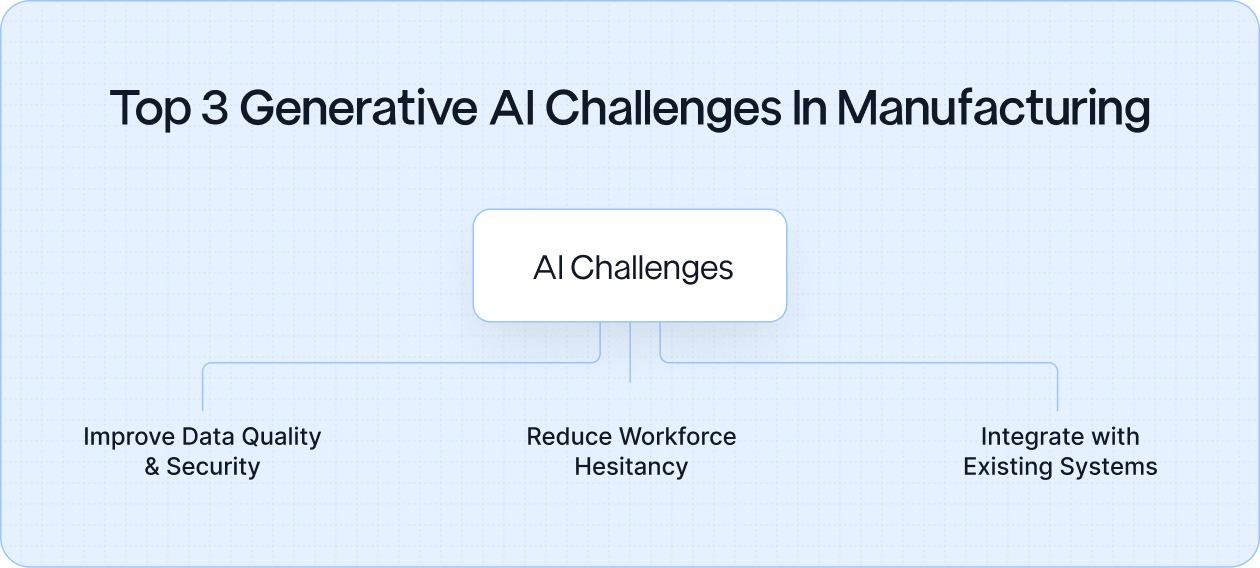
Here’s a look at some of these challenges and how to overcome them effectively.
Many manufacturers assume they need massive, perfectly structured datasets before AI can deliver value. In reality, most already sit on years of usable data across production logs, machine reports, documents, and customer interactions.
AI performs best when it works on:
By grounding AI outputs in verified internal data, manufacturers reduce risk while improving trust in results. This makes AI usable for real decisions, not just experimentation.
Outcome: AI becomes a reliable support system instead of an unpredictable black box.
For many SMB manufacturers, AI hesitation has less to do with fear of job loss and more to do with bandwidth. Teams are already stretched across production, operations, sales, and customer support.
The practical solution is not asking internal teams to become AI experts. Instead, successful SMBs adopt AI through guided systems and managed execution models that deliver outcomes.
By separating AI capability from AI execution, manufacturers gain the benefits of AI without forcing teams to change how they work day-to-day.
Outcome: Reduces resistance, shortens adoption timelines, and prevents common pitfalls like tool sprawl, misuse, or low-quality outputs.
Legacy systems are common in manufacturing. ERP platforms, MES tools, and documentation systems were not built with generative AI in mind. Full system overhauls are expensive and risky, especially for SMBs.
For example, AI can generate maintenance summaries, draft technical documents, or surface operational insights without touching core systems initially. This avoids disruption while building confidence.
Outcome: AI adoption progresses steadily without breaking existing operations.
Generative AI requires creating smarter, more sustainable ways to operate and ensuring that manufacturers can meet future demands in a rapidly evolving world.
Sustainability is becoming a top priority for manufacturers, and AI is here to help in a big way. Here’s how:
Generative AI is helping to make manufacturers greener, contributing to a more sustainable future.
The future of manufacturing looks a lot smarter, thanks to AI. Here’s what to expect:
This interconnected system will give manufacturers deep insights, making it easier to improve every part of their operation.
Generative AI is going to make manufacturing more agile, sustainable, and efficient, creating a future where companies are leading the way in innovation and sustainability.
Generative AI delivers value when it helps manufacturers make better decisions, reduce wasted effort, and focus teams on work that actually moves the business forward.
On the factory floor, this shows up as fewer surprises, clearer maintenance priorities, and steadier output. Outside the plant, it shows up as better visibility, clearer technical messaging, and inquiries that match real production capacity. For SMB manufacturers, these gains matter more than adopting advanced systems all at once.
The most effective way to start is where results appear early, and risk stays low. Improving how buyers find you, understand your capabilities, and reach out with clear intent often delivers faster impact than deeper operational AI projects.
For manufacturers taking this approach, Gushwork provides a practical entry point. It helps manufacturers use AI-assisted SEO and content systems to attract qualified demand consistently, without expanding internal teams or changing how work gets done.

Laundry services sell something people use often but think about very little. That’s the challenge. When a service feels ordinary, customers default to whatever name they notice first or whatever option seems simplest. Marketing becomes the tool that lifts your business out of that blur. It shows people what makes your service worth choosing, even when they aren’t actively comparing providers.
Marketing also shapes expectations. It tells customers what quality looks like, what convenience should feel like and what level of care they can expect from a professional service. Without it, every provider seems the same, which pushes buyers to choose based on confusion.
In this blog, you’ll learn how laundry service marketing actually works today, what drives customers to choose one provider over another and the practical strategies that help your business stay top-of-mind when people need help the most.
Laundry service marketing is the process of attracting more customers to your pickup-and-delivery or in-store service by improving your visibility, building trust, and consistently communicating your value across online and offline channels.
Unlike traditional retail, laundry relies heavily on:
Marketing for laundry services focuses on showing up in local searches, creating a smooth digital experience, building credibility through reviews, and using well-timed promotions to turn first-time users into loyal weekly customers.
Marketing a laundry service is about being visible where your customers already are: on their phones, in their apartment buildings, at local businesses, and in their inboxes. These strategies work best when you use them together:
Digital marketing is how your laundry business appears online: your website, your content, your online ads, and the words people use to find you (keywords). For a local laundry, this is often the first impression someone gets before they ever see your shop or van.
What your setup should include:
Your website should explain your service clearly and make booking simple. Most customers skim, so clarity matters more than design trends. A good website removes confusion and reduces the number of questions you’re answering over the phone.
What to include:
Good content helps customers understand how your service works and reduces uncertainty for first-time users. It also builds authority with Google, helping you rank for the terms people search.
Useful content ideas:
How to present it:
Keywords are the terms customers type into Google when they need laundry services. Using them naturally on your website helps search engines understand what you offer and where you serve.
Keywords to target:
Where to place keywords:
Use them naturally, never force them.
PPC (Pay-Per-Click ads) puts your business in front of people who need laundry service right now, especially useful for urgent, same-day, or pickup-focused searches. It’s the quickest way to get bookings while your SEO is still growing.
How to run effective PPC:
Digital marketing is your “always on” engine, even when your shop is closed, your website and ads can still bring you new customers.
SEO (search engine optimisation) is about making sure Google understands:
So when someone searches, you show up without paying for every click.
You need the following to speed things up:
Ensure your business details are identical on:
Consistency helps Google trust your information.
Make your site easy to understand by:
Build trust outside your site:
This combination tells Google: “We are the laundry service people here actually use.”
Local physical branding is everything people see in the real world: your bags, your vans, your storefront, your flyers. It helps people connect the online brand they saw on their phone with a real, trustworthy business.
What to focus on:
Branded laundry bags give your business visibility wherever customers carry them. Adding your logo, contact details and a simple prompt like “Scan to schedule your next pickup” turns every bag into a quiet ad that moves through apartments, offices and shared spaces.
Vehicle branding works the same way. Even simple magnetic signs help people associate your name with pickup and delivery. Keep the message clean with your brand name, service type, service area and a quick way to contact you. Parking in areas where your ideal customers live or work reinforces that recognition.
Your storefront should communicate your services at a glance. Clear lines such as “Pickup and Delivery Available” or “Wash and Fold by [time]” make it easy for people to understand what you offer. Clean windows, readable signage and visible hours help passersby trust and remember you.
Physical touchpoints extend your visibility further. Door hangers in approved buildings, flyers in gyms or co-working spaces and partner placements in student housing or serviced apartments all keep your name in front of people who are likely to use a laundry service.
Good physical branding backs up your digital efforts and builds familiarity: “I’ve seen that name before.”
Social media for laundry is about being visible and trustworthy, where your customers scroll daily. Paid social ads (Facebook, Instagram) help you target people in your exact service area.
What to post
Paid social works best when you keep the targeting simple and rooted in location. Focus on ZIP codes, a radius around your shop or specific audience segments if they make sense for your market such as students, young professionals or families.
Your ads should highlight offers that are easy to understand. Intro discounts, new area launches or subscription plans tend to perform well because customers can act on them without much thought.
Make sure every ad sends people somewhere that reduces friction. A straightforward landing page works well, but direct options like messaging, WhatsApp or click-to-call often convert faster for local services.
Social media builds familiarity. Paid ads turn that familiarity into first orders.
Email and SMS marketing help you stay in touch with people who already know you. For laundry services, retention is everything, it’s more valuable to keep a weekly customer than to chase new people every day.
How to use it:
Email and SMS work best when they guide customers through simple steps. A welcome sequence after the first order sets the tone. Thank them, show them how to schedule their next pickup and share a brief note about how you care for their clothes. This creates confidence and makes repeat use easier.
Reminders help maintain momentum without feeling pushy. Short messages like “It’s been two weeks since your last pickup, want us to swing by?” or “Spots open for tomorrow’s route in [Neighbourhood]” keep your service top of mind and make it easy for customers to act with one tap.
Keep messages short, friendly, and clear. People check their phones quickly. Do not overload.
Every interaction, WhatsApp message, phone call, pickup, delivery, shapes how people talk about your business. Good communication becomes free marketing; poor communication destroys it.
What you need to setup:
When customers feel informed and respected, they’re far more likely to stay, refer, and forgive small mistakes.
Your existing customers are your best marketers. Reviews build online trust. Loyalty rewards keep people from drifting to competitors. Referrals bring you similar, high-quality customers.
What to do
These levers help you move from one-off jobs to predictable, repeat revenue.
Technology doesn’t replace good service; it supports it. The right tools make it easier for customers to book, and for you to track what’s working.
Useful tools
Even simple tools (Google Sheets + a basic CRM or booking app) can give you enough data to decide where to spend your time and money.
A marketing plan for a laundry business doesn’t need to be complicated. It should simply tell you what you’re trying to achieve, who you’re targeting, where you’ll focus, and how you’ll measure progress:
Before you choose channels or tactics, you need to know what “success” looks like. Clear objectives stop you from chasing random ideas and help you decide where to invest time and money.
Not everyone is your customer. A clear picture of who you serve and where they live makes all of your marketing more focused and cost-effective.
If your routes are too wide or random, your costs will affect your profits. Service rules keep operations efficient while you grow.
Your marketing budget should reflect your goals and what you can realistically manage each month.
For laundry services, reviews and word-of-mouth are often more powerful than any advert. Making reviews part of your process keeps trust growing steadily.
You just need a small set of numbers you track consistently so you can see what’s working.
Here’s are some challenges you face in marketing, when they are not part of your daily process:
People search “laundry near me” or “pickup and delivery laundry” and click the top three results. If competitors invest in SEO, ads, and Google Business Profile updates, they appear instantly, while your listing stays buried. Over time, you stop being an option, even for customers right in your service area.
Without ongoing marketing, you rely on walk-ins, occasional referrals, or random demand spikes. This leads to:
When you ignore marketing, every customer feels “hard-earned.” You may spend more on discounts or last-minute promotions because you’re not building long-term visibility. Businesses with consistent online presence enjoy lower acquisition costs because customers find them organically over time.
Laundry services thrive on repeat customers, weekly, bi-weekly, or monthly. When marketing is absent:
Marketing ensures customers stay engaged, come back consistently, and refer others.
Without consistent demand, it’s difficult to:
Laundry is one of those services people rarely plan for, yet rely on constantly.
Marketing for your laundry service puts you top of mind the moment someone needs a pickup. Build that clarity. Build that trust. And your laundry service becomes the first choice, not the backup option.
Your next loyal customer might be one busy day away. Let your marketing make that decision simple.

Most homeowners don’t have a “go-to” drain cleaner. They don’t keep a list of specialists. They don’t know which companies are genuine experts, and they definitely can’t tell the difference between a pro who’s been in business for a decade and someone who started last month.
So what do they rely on?
This is why drain cleaning leads go to businesses that present themselves clearly, show proof instead of promises and look like they’ll actually pick up the phone.
In this blog, you’ll learn how drain cleaning customers really choose a provider, what drives them to trust one contractor over another and the exact strategies that turn that trust into a steady pipeline of high-quality leads.
Drain cleaning leads stand out because they convert fast, produce ongoing work and often turn into higher-value jobs.
Homeowners usually experience drain issues without warning, which pushes them to hire immediately instead of shopping around. This urgency, paired with the natural add-on services that follow, makes drain cleaning one of the strongest revenue drivers in home services.
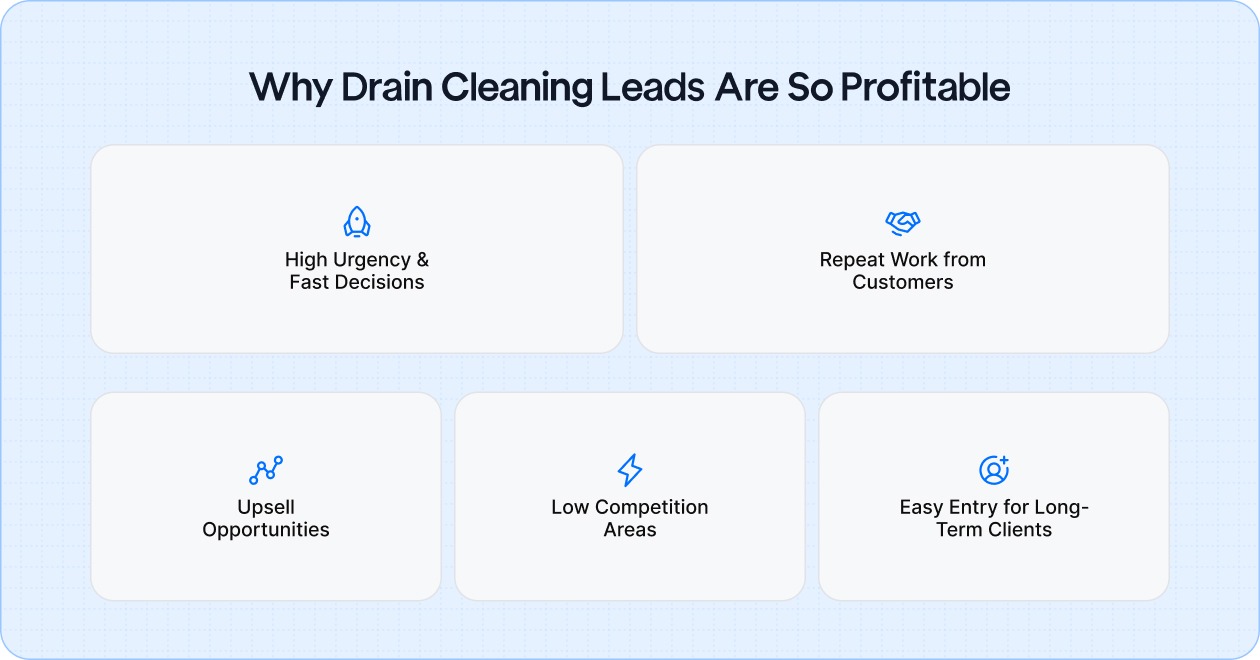
Here’s what makes these leads so profitable:
Below are the core factors that shape drain cleaning lead generation today:
Homeowners respond very differently depending on the severity of the issue.
Understanding both behaviours helps you position your marketing for both instant calls and long-term awareness.
Three factors control whether a drain cleaning lead becomes a booked job:
Drain cleaning has immediate demand, but long-term success comes from building a recognizable, reliable presence.
Not all leads are created equal, especially in drain cleaning.
The strongest drain cleaning businesses rely mostly on exclusive leads because they produce higher revenue, better customer relationships, and repeat work.
To turn drain cleaning demand into booked jobs, your business needs a system that attracts the right callers and moves them quickly into your schedule. The following lead strategies reflect what’s working best for contractors in 2026:
Direct outreach means intentionally connecting with the professionals who spot drain problems long before a homeowner does. These partners deal with plumbing, property issues, and inspections every day, so they often guide the homeowner’s decision on who to call.
Why is this powerful:
Where to start:
How to create partnerships that last:
Most drain cleaning leads start on Google Maps or Google Search. When someone types “drain cleaning near me,” the top three results get nearly all the calls. Your job is to make sure you show up there every time.
What matters most:
Your Google Business Profile is often the first place customers see your business. It appears inside Google Maps and at the top of local search results, showing your phone number, reviews, photos and availability.
What to set up:
A strong GBP listing is often the single most important lead generator for drain cleaning businesses.
Many homeowners use iPhones, which means Apple Maps often becomes their default search tool. Apple Business Connect lets you claim and manage your listing so you appear correctly in Apple Maps, Siri searches and iPhone navigation recommendations.
Your service page should clearly explain what you fix and how quickly you can help. Most homeowners skim for answers, so your page needs to be simple, direct and reassuring.
What to do:
Customers lose interest quickly if they aren’t sure you serve their area. Clear coverage info removes confusion and tells both Google and homeowners exactly where you work.
What to do:
This is called NAP consistency. If your business name, address or phone number appears differently across the internet, search engines get confused and may not show your listing.
What to do:
Internal links are the small clickable connections between your pages. They help visitors navigate quickly and help search engines understand your website better.
What to do:
Schema is code added to your website that gives search engines extra clarity about your business. It helps Google understand who you are, what you do and where you’re located.
What to do:
Local citations are listings of your business name, address and phone number on trusted directories. Think Yelp, Angi, HomeAdvisor, BBB, and strong local business indexes.
Why it matters:
The more accurate citations you have, the easier it is for Google to verify your business location. Verified businesses rank higher for searches like “drain cleaning near me,” which leads to more local calls.
EEAT stands for Expertise, Experience, Authority and Trust. These signals show customers and Google that you’re a real, skilled, trustworthy drain cleaning company.
What strengthens EEAT:
Local SEO wins because it connects you with customers exactly when their sink, tub or main line stops working and they’re ready to book immediately.
Some of the highest-value leads come from everyday local presence and good old-fashioned conversations.
What works today:
Direct mail means sending physical postcards or flyers to homes in targeted neighborhoods. It works especially well in areas with older plumbing, where clogs and backups happen more often.
Why it works:
When the next clog happens, your card is already on their fridge or counter, making you the first call.
Cold calling means reaching out to businesses that frequently deal with plumbing issues, especially restaurants, small shops and property managers. These businesses rely on fast, reliable help and often need repeat service.
Why it works:
You become their go-to tech for emergencies, maintenance and recurring needs, giving you predictable revenue.
Community networking puts you in rooms with people who influence repair decisions: landlords, contractors, HOA leaders and local business owners. These groups often refer work to people they’ve met personally.
Why it works:
You position yourself as the dependable drain specialist in your community, leading to steady referrals without extra marketing spend.
People remember the face they met, and in urgent jobs, familiarity beats price almost every time.
A good website doesn’t need fancy animations. It needs speed, clarity and a layout that lets desperate customers book within seconds.
Why the site matters:
Most homeowners don’t scroll. They skim for:
If those answers aren’t clear in 5 seconds, they hit back.
What to include:
When your website makes the customer feel understood and gives them confidence, they stop shopping and call you.
Want to see how your current site stacks up? Run it through our AI Analyzer for instant recommendations that help turn more visitors into booked jobs.
Paid ads help fill your schedule quickly, especially during slow months. This works well because drain cleaning searches show urgent, purchase-ready intent.
Channels worth paying for:
Google Search PPC ads show your business at the very top when someone types in a drain cleaning keyword. These leads are usually urgent and ready to book immediately.
Why it matters:
Local Services Ads appear above standard PPC results and display the “Google Verified” badge. This badge is only awarded after a business passes Google’s full vetting process, including background checks, license and insurance verification, and professional screening. It signals that your business is trustworthy, not just well-advertised.
Why it matters:
Meta ads are ideal for staying in front of homeowners who visited your site, clicked your ads, or showed local interest. They’re not usually for emergency situations but work extremely well for awareness and seasonal services.
Why it matters:
Offline ads still work extremely well for home services, especially drain cleaning. They place your brand directly in the areas where real issues happen.
Why it matters:
How to judge your ad spend:
Paid ads work best when paired with a website that converts well.
Content builds long-term authority. When people see that you understand drain problems and explain them clearly, they’re more likely to choose you over competitors.
Content that performs well:
Blogs written around real questions homeowners ask help you show up in local searches and build authority in your service area. These blogs capture homeowners early, especially when they’re researching symptoms. These posts don’t need to be long. They just need to answer simple questions clearly.
Why it works:
Simple repair videos show the problem, how you fixed it and the final result. They’re easy for customers to understand because they can see the solution.
Why it works:
These are slightly longer videos that explain common drain problems, what causes them and what homeowners should look out for. They are not meant to teach DIY fixes. They are meant to help customers understand when a repair is needed.
Why it works:
These are 10–30 second clips for platforms like Instagram Reels, Facebook, TikTok and YouTube Shorts. They show quick wins, fast fixes or simple tips.
Why it works:
This content becomes the foundation for your SEO, your retargeting ads and your social proof.
Trust is everything in drain cleaning. One fresh review can generate multiple new calls.
What to set up:
Your reputation should work like a flywheel; once it starts spinning, it keeps bringing in leads.
Drain cleaning flourishes on local familiarity. If people see your truck around town, they feel like they already know you.
Branding that works:
A clean, well-branded truck is one of the most cost-effective marketing tools in drain cleaning. Your truck is seen by thousands of people each week, especially in neighbourhoods where you already work.
Uniforms and branded gear signal professionalism. They make customers feel at ease when letting you into their home and reinforce that you're a legitimate contractor, not a random technician.
After you finish a job, placing door hangers around nearby homes is a simple way to capitalize on local demand. People rarely address plumbing issues until they’re reminded.
Showing up in the community builds trust in a more genuine way than ads can. Homeowners like hiring service providers who contribute locally.
Visibility builds trust before homeowners ever need your service.
Most visitors won’t call right away. Retargeting brings them back at the exact moment they’re ready.
Easy ways to implement this:
You avoid losing warm leads, and every follow-up increases bookings.
Once your base systems work, advanced tactics help you scale.
What advanced companies do
These small strategic steps help you move from “busy” to “predictably booked.”
Growing a drain cleaning business isn’t about reacting to whatever calls come in. It’s about creating a presence that earns trust before someone even needs you. When your brand looks reliable, your pages answer real questions and your visibility stays strong, customers start choosing you without hesitation.
The more you invest in the right visibility and trust signals today, the easier it becomes to attract better jobs, build long-term customer relationships and scale your business with confidence.

Have you ever looked at your marketing reports and thought, “This tells me a lot, but none of it helps me understand if we’re actually getting good prospects”?
Most manufacturers are stuck there. But just like production, marketing only works when you’re measuring the right things. That’s why tracking meaningful KPIs is critical.
In this guide, we’ll break down the marketing KPIs that matter most for manufacturing companies.
Marketing in manufacturing doesn’t behave like traditional B2B or B2C. Your buyers make decisions based on risk, reliability, engineering fit, and supply-chain stability. That changes what you measure, how you measure it, and why the metrics matter.
Here’s what makes marketing metrics for manufacturing companies fundamentally different:
A manufacturing deal primarily involves engineering, purchasing, quality, operations, and finance, each influencing a different part of the decision. Your metrics must reflect this shared evaluation process, not single-user actions such as clicks or form submissions.
Engineers and buyers often research your capabilities silently, downloading datasheets, checking tolerances, or reviewing certifications months before they ever request a quote. That means your KPIs must track technical engagement signals, not just visible conversions.
Ten unqualified prospects drain engineering time, while one well-matched opportunity from a target prospect can drive years of revenue. Manufacturing KPIs must prioritize opportunity quality over raw sales volume.
A prospect only matters if the part, material, volumes, and certifications align with your manufacturing capabilities. That’s why KPIs should focus on qualified opportunities.
Manufacturers win through long-term relationships, where one good program can grow into multi-year, multi-plant recurring revenue. Your metrics must reflect this slow-build ROI rather than short-term campaign spikes.
Manufacturing buyers move through a technical, engineering-heavy path:
specs → samples → RFQ → approval → production
Your KPIs should align with each of these real-world stages, not generic marketing funnel assumptions.
These exact challenges are why many manufacturers struggle to turn marketing into revenue. Here’s a suggested read to help out: If Your Revenue Isn’t Growing Despite Digital Marketing Spend, This Could Be The Reason. Let’s Solve It
The metrics below are built around this path.
The right KPIs show where your best buyers come from, which channels waste engineering time, and how well your marketing is supporting sales with technical clarity and buyer confidence.
Here are the best marketing metrics for manufacturing companies:
This shows the real potential revenue your marketing is responsible for generating. The total value of opportunities or quotes that entered your pipeline because of a marketing touch, such as:
For manufacturers, quoting and sampling are expensive. This metric shows how much real business your marketing is feeding into the system, not just how many people downloaded a brochure.
How to measure it
Over time, you want the marketing-sourced pipeline to grow faster than your spend.
This metric tracks prospects your factory can realistically win and fulfill profitably.
These are buyers who match your ideal customer profile, industry, size, geography, and whose projects align with your technical strengths, such as materials, tolerances, volumes, and required certifications.
For most manufacturers, these qualified opportunities are the prospects that truly matter, and this KPI keeps your focus on quality over volume..
How to measure it
When you change your marketing, you should see not just “more sales” but “more of the right kind of sales.”
This shows the percentage of quotes that convert into purchase orders, grouped by the marketing channel that created the opportunity.
To calculate:
Quote-to-order rate = Number of quotes that became orders / Total quotes sent × 100
In manufacturing, a lot of time goes into quoting. A high volume of low-win quotes drains engineering and sales capacity. Looking at the win rate by marketing source tells you:
How to measure it
This refers to the total marketing spend required to generate one qualified opportunity. It tells you how expensive (or efficient) it is for your marketing to bring in a good prospect.
Here’s how you can calculate this:
Cost per qualified Prospect = Total marketing spend for a period / Number of qualified prospects in that period
Generic “cost per lead” can be misleading. As mentioned earlier, 10 unqualified opportunities from tiny buyers may be worth less than one prospect from a strategic Business Partner.
This metric helps you compare channels on real commercial impact.
How to measure it
This metric shows whether the right companies are visiting your website. In manufacturing, traffic volume is usually low but high-value, so the goal isn’t millions of views. You want design engineers, procurement teams, and technical buyers from your target industries engaging with your data sheets, application notes, and case studies.
Modern tools can identify company-level visits using IP-to-company matching, first-party data, and CRM integrations. This lets you see whether target industries or named accounts are actually landing on your site, even if the individual visitor stays anonymous.
How to measure it:
This gives you a real sense of whether your marketing is attracting qualified buyers, not random traffic.
This identifies buyers who may be preparing to spec you into a design or request a quote. Engagement with high-intent technical assets, such as:
In manufacturing, an engineer who downloads your stack-up guide or CAD model is much closer to specifying your product than someone who just skims through a blog. Many industrial marketing teams treat these as “design-in” indicators, which strongly correlate with future prospects.
How to measure it
This is a direct measure of how well-aligned your sales and marketing teams are on prospect quality and readiness. It reflects the percentage of marketing-qualified leads (MQLs) that sales actually accept and work as sales-qualified leads (SQLs).
MQL→SQL rate = Number of prospects accepted by sales / Total MQLs sent to sales × 100
This metric shows whether your marketing team and sales team agree on what a good prospect looks like for your manufacturing business.
How to measure it
Over time, this alignment improves prospect scoring, content focus, and channel mix.
This tracks how long it takes a qualified prospect to move from first interaction to closed-won business. In manufacturing, each stage (Request → quote → sample → PO) can take weeks or months. This metric helps identify where prospects slow down or stall.
Complex industrial deals can take months or longer. If marketing is doing its job, you often see:
How to measure it
What they are:
Marketing leadership needs to know:
How to measure them
This keeps “growth at any cost” in check and supports decisions on where to focus prospecting.
This tracks return on Investment (ROI) and gross margin growth from your current customer base, influenced by marketing (upsells, cross-sells, new programs).
For manufacturing companies, expansion within existing accounts (more lines, new plants, additional product families) often delivers better margins than constant new logo chasing. Ongoing marketing, technical newsletters, product updates, and co-branded webinars play a big role here.
How to measure it
This helps justify marketing programs that look “retention-focused” but quietly produce big, compounding gains.
Marketing gets easier the moment you start tracking the right KPIs. You stop guessing. You stop reacting. And you begin making decisions based on how buyers actually behave and which efforts produce real results.

Ever look at other junk removal companies and wonder how they stay busy all week while you’re waiting for the next call? Most of the time, it’s because customers notice them first. People search, pick the business that looks solid, and move on with their day.
That’s why your marketing matters. You need to know and implement the basics that help people see what you do, trust it, and contact you without thinking twice.
In this blog, you’ll learn what junk removal marketing actually is, why it matters even if you’ve been doing this for years, and the simple steps that bring in steady, good-quality jobs.
Junk removal marketing is the practice of promoting your junk removal services to attract more clients, build a solid reputation, and increase job bookings. As a junk removal business, your goal is to ensure that your services are easy to find when potential customers search for solutions to their clutter problems.
Effective marketing for junk removal businesses involves a combination of strategies that target local customers, highlight your unique value, and build trust in your community.
Here’s why it matters:
When someone needs junk removal, they don’t plan it days ahead. They search on their phone and pick the first business that looks real, available, and reliable. If your business isn’t visible online, they won’t even know you exist.
Many people will choose the cheapest-looking option if they can’t tell the difference. A clear online presence shows your pricing, photos, reviews, and services, so customers see the value you offer.
A strong marketing setup helps filter out low-value calls and attracts people who actually need full cleanouts, appliance removal, or recurring work. When your message is clear, the right customers come in.
People don’t want strangers showing up at their home without knowing who they are. Good marketing shows real photos, honest reviews, and clear details about your work. That trust makes customers comfortable to book.
A strong marketing strategy helps people find you, trust you, and choose you. Without it, you’re relying on chance in a business where people decide quickly and move on even faster.
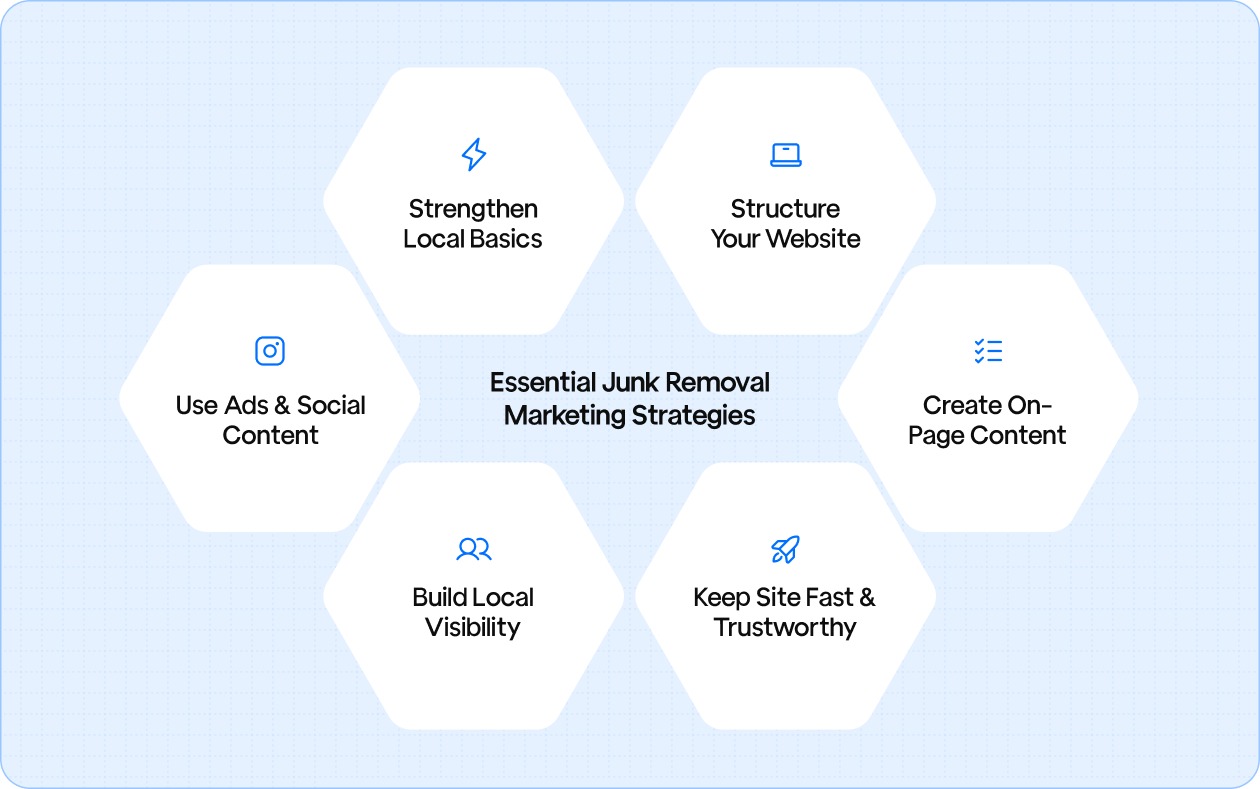
These strategies help your junk removal business get found, trusted, and chosen:
Local visibility is the heart of junk removal marketing. Most people look for the nearest reliable option and choose one of the first results they see. That makes your foundation the most important part of your marketing.
Here’s what this foundation includes:
Pro Tips:
When someone visits your website, they want answers right away: what you do, where you work, and how to contact you. A clear structure guides them to these answers with no confusion.
The most helpful pieces include:
Service pages: Simple pages that explain each job type, such as furniture removal, garage cleanouts, appliance disposal, or construction debris.
Pro Tips:
One page per main service helps searchers find exactly what they need and call quickly.
Pro Tips:
Good on-page content is nothing more than clear language, helpful images, and simple explanations. It shows customers exactly what you do and helps Google understand your business.
Here’s what matters most:
Pro Tips:
Your website is often a customer’s first impression of your business. If it feels unreliable, slow, or confusing, they move on to the next option.
A trustworthy junk removal website should:
These details build confidence and help you earn more calls.
Here are some tools you can use to track your page’s performance:
Search engines look at where your business is mentioned online. Mentions from trusted local places tell search engines that your business is active and legitimate in your community.
Ways these mentions appear include:
Paid ads and social content help you reach people at the moment they decide they need junk removal. These channels work well because customers often act immediately once they decide they want the clutter gone.
This includes:
Here are the most common issues that slow down growth and how to avoid them.
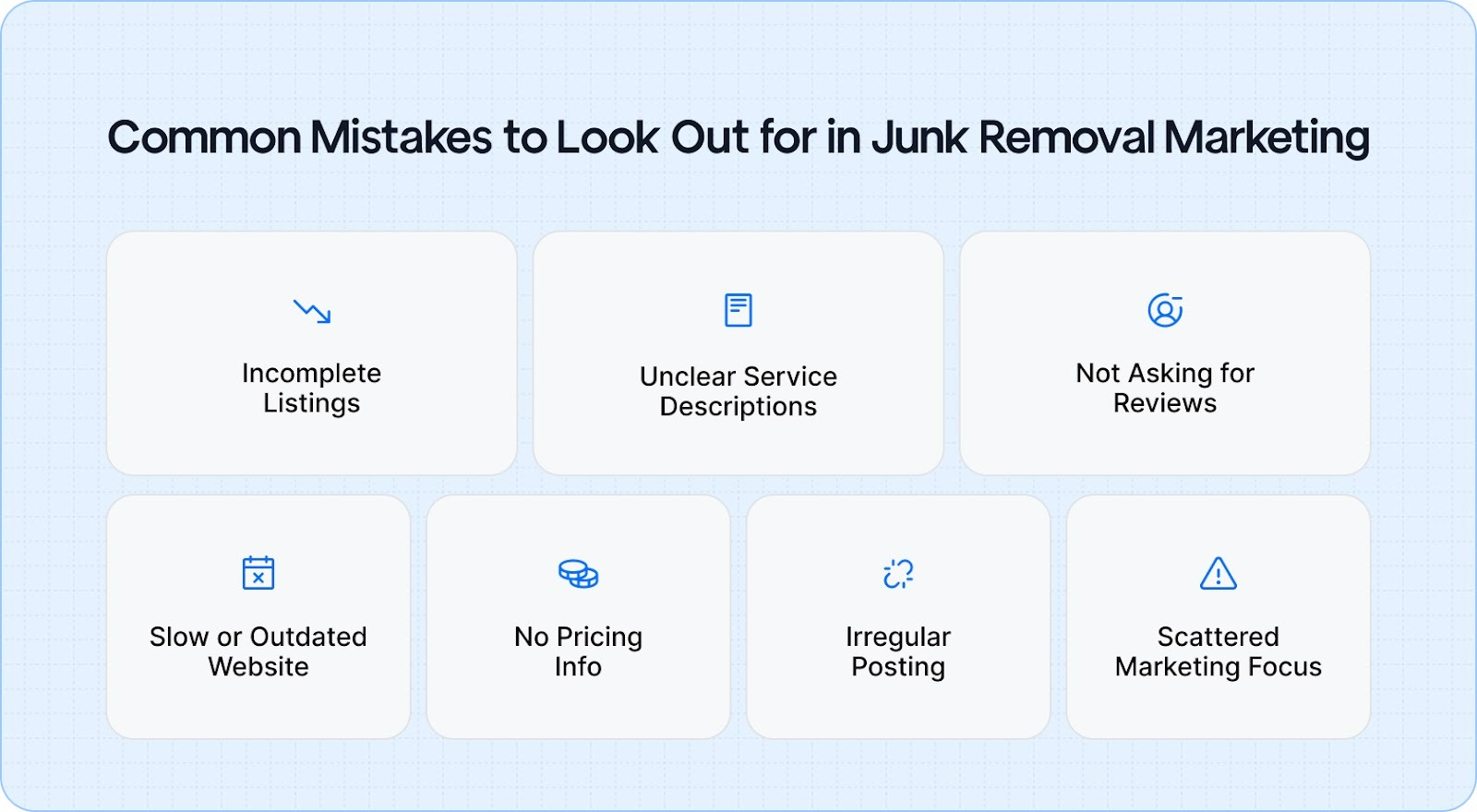
1. Missing or incomplete online listings: If your Google Business Profile or Apple Business Connect is half-filled or outdated, customers will skip you. Missing hours, no photos, or old phone numbers make your business look inactive.
2. Using unclear or confusing service descriptions: Calling yourself “full-service removal” isn’t enough. Customers need to see clear wording like “garage cleanouts,” “mattress removal,” or “appliance hauling.” Vague language makes people leave your page and pick someone else.
3. Forgetting to ask for reviews: Reviews are the biggest trust factor in this industry. If you finish jobs without asking for a review, you’re missing out on the easiest way to stand out and rank higher.
4. Having a slow or outdated website: If your site takes too long to load or doesn’t work well on phones, people won’t wait. A slow site suggests slow service, even if you’re great at the job.
5. No pricing cues anywhere: Customers hate guessing. When you don’t share starting prices or simple cost ranges, people assume you’re expensive or unreliable.
6. Posting only once in a while: Irregular posting makes your business look inactive. Weekly updates on Google, Apple, or social platforms keep you visible and relevant in your area.
7. Trying too many marketing tactics at once: Many junk removal owners jump from ads to flyers to SEO without giving anything time to work. Marketing gets easier when you focus on a few basics: GBP, a clear website, good photos, and reviews.
By understanding your audience, creating a strong online presence, gathering reviews, forming partnerships and tracking your results, you position your business for sustainable growth.
At Gushwork, we specialize in:





.svg)
.svg)
.svg)